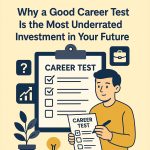Career News
The Power of Alignment: How Your Passions and Motivations Drive Career Success and Fulfillment

The Power of Alignment: How Knowing Your Passions and Motivations Transforms Work, Fulfillment, and Career Trajectory
Most careers are not lost to lack of talent. They drift off course because the day-to-day work fails to match what a person actually finds energizing. If you have ever caught yourself thinking “I can do this job, but I don’t want to do this job,” you have already met the core problem: misalignment between your motivations and your work. The fix is not a slogan about “following your passion.” It is the practical craft of discovering what truly drives you, then engineering your role, routines, and long-term choices around those drivers. When you do that, the compounding benefits are profound: better performance, faster learning curves, deeper resilience, and a step-change in long-term career success.
This article is a field guide to identifying and harnessing your passions and motivations. You will learn how motivation works, how to translate personal drivers into daily decisions, how alignment unlocks outsized results, and how to course-correct when your role drifts away from your natural energy. We will also show you a proven, data-rich way to map your motivational profile and link it to real work options.
1) What “passion” really is (and what it isn’t)
“Passion” is often treated as an emotion that you either feel or you don’t. In practice, passion at work shows up as consistent energy applied to a specific kind of challenge. It is not a flash of enthusiasm. It is the reliable desire to come back tomorrow and do the next hard thing.
Three clarifications help:
- Passion is pattern, not a single topic. You might think you are passionate about “marketing,” but underneath that are patterns such as persuading through words, testing hypotheses, building systems that scale, or coaching others to present their ideas. The label is less useful than the motivational pattern inside it.
- Motivation precedes mastery. People get good at the things they are motivated to practice. Passion does not guarantee talent, but it maximizes the time on task that builds talent.
- Enjoyment and meaning are different but complementary. Tasks you enjoy give short-term energy. Work you find meaningful creates long-term staying power. The roles you should chase give you both.
2) The mechanics of motivation
Motivation is not random. It has consistent contours you can measure and use. Think of six practical levers:
- Problem type. Are you energized by open-ended puzzles, people problems, operational puzzles, or aesthetic craft?
- Time horizon. Do you come alive solving immediate issues or designing long arcs?
- Autonomy. Do you want full control and ownership or do you prefer defined frameworks and clear guardrails?
- Pace and variety. Do you want rapid context shifts or deep focus?
- Collaboration mode. Do you gain energy from leading, partnering, serving as a specialist, or flying solo?
- Result style. Do you want visible wins, quiet reliability, social impact, or intellectual elegance?
When your daily work aligns with your preferred levers, effort feels lighter and output improves. When it misaligns, everything drags. The lesson is simple: do not chase generic job titles. Chase work environments and task mixes that match your motivational levers.
3) Why alignment multiplies career outcomes
People who work in alignment with their core motivations enjoy advantages that compound over time.
- Higher sustained effort
Motivating work reduces the internal friction that kills consistency. You do more high-value reps, which produces better skills, which earns bigger opportunities.
- Faster skill acquisition
Motivated practice is focused practice. You do not just put in hours. You seek feedback, try new approaches, and iterate. Learning curves steepen.
- Better performance under pressure
Stress tests are easier to pass when the underlying task energizes you. Alignment buffers you against burnout because the work itself returns energy.
- Credibility and brand
People can sense when you are operating in your lane. You communicate with conviction, ship with reliability, and attract collaborators who value what you bring.
- Trajectory advantages
Aligned performers are first in line for stretch assignments that further reinforce strengths. Over a decade, this flywheel pulls you far ahead of equally intelligent but misaligned peers.
4) Discerning motivations from “should”
Many professionals confuse external expectations with internal energy. To separate the two, ask:
- When are you impatient to start? Those tasks pull you forward without external pressure.
- Where do you keep expanding the scope voluntarily? You add complexity because the problem is intrinsically interesting.
- Which victories feel satisfying rather than merely relieving? Relieving victories end stress. Satisfying victories create joy and appetite for more.
- What do people consistently ask you for? External demand often reveals a native strength you enjoy using.
Write three “peak moments” from the last two years and dissect them with those questions. Patterns emerge quickly.
5) The Alignment Map: turn motivations into role design
An Alignment Map converts your motivational profile into daily choices. Build it in four steps.
- List energizers and drainers. Energizers are specific tasks and contexts that increase your energy. Drainers do the opposite. Be concrete: “coaching early-career sellers 1:1,” not “helping people.”
- Translate into role ingredients. Energizers become non-negotiable ingredients you actively pursue. Drainers become constraints you minimize or outsource.
- Design the daily plan. Assign time blocks to energizers first. Protect them. Cluster drainers into short, contained windows or trade them away through collaboration.
- Negotiate the environment. Alignment thrives with the right manager, metrics, and tools. Share your plan, make explicit tradeoffs, and demonstrate how the mix will improve results.
This is not wishful thinking. It is a performance plan built on the most durable fuel you have.
6) Alignment in different career stages
Early career: sampling and signal
Your job is to test assumptions quickly and honestly. Seek projects that let you try different problem types, time horizons, and collaboration modes. Keep a simple “energy ledger” where you rate weekly tasks from +2 to −2. After eight to twelve weeks, the signal is strong. Use it to request more of the +2 work and less of the −2 work.
Mid career: consolidation and leverage
Here you transform strengths into systems. You standardize how you create value, document your playbooks, and build tools so that your output multiplies through a team or platform. Alignment work now includes boundary setting so that expanding responsibility does not flood your calendar with low-energy tasks.
Senior leadership: orchestration
At this stage you cannot do only what you love. But you can staff to your gaps and spend your time where your motivation yields the greatest enterprise value. Leaders who stay aligned model sustainable excellence and attract talent that wants to do the same.
7) Aligning in less-than-perfect jobs
You do not need a perfect job to be aligned. You need an aligned ratio.
- Shape the scope. Volunteer for projects that match your energizers and deliver fast wins. Use those wins to negotiate more of the same.
- Trade tasks. Swap a drainer you carry for an energizer a teammate likes. Everyone wins.
- Automate or templatize drainers. If you must do them, make them smaller. Templates, checklists, and tools compress low-energy work.
- Protect peak hours. Put energizer tasks in your natural high-focus windows. Defend those blocks.
Over a year, small shifts can flip your ratio from 30 percent aligned to 70 percent aligned. That is often enough to change your trajectory.
8) The role of values and meaning
Motivation without meaning leads to productive burnout. Meaning without motivation leads to noble frustration. You need both.
Values answer the question why this work matters beyond your personal progress. When your daily work aligns with your motivations and advances a purpose you respect, the result is durable engagement. If you find yourself aligned on tasks but misaligned on purpose, adjust the customer, the problem domain, or the mission narrative. Often the “meaning gap” is not the work itself but the story you are telling about the work.
9) The social multiplier: teams and managers
Alignment scales through teams. Leaders who know their people’s motivations can distribute work so that each person spends more time in their energizers. The team gains:
- Speed, because tasks land with people who want them.
- Quality, because energy drives better craft.
- Resilience, because aligned work buffers stress.
Managers should ask three questions in every 1:1 at least quarterly:
- Which recent tasks gave you the most energy?
- Which tasks drained you, even if you performed well?
- What trade can we make to increase the ratio of energizers?
Pair those answers with measurable outcomes so alignment is never confused with indulgence. It is a tool for performance.
10) Motivation, money, and risk
Compensation and passion are not enemies. In the short run, money can buy time, tools, and options. In the long run, misalignment is expensive. You will put in fewer high-quality reps, get fewer breakout chances, and burn more energy to achieve the same outputs.
If you are weighing a high-pay misaligned offer against a slightly lower-pay aligned role, ask:
- Will the aligned role accelerate skills that compound?
- Will it build a reputation that attracts better opportunities later?
- Will it protect my energy so I can do excellent work for years?
If the aligned role scores higher on those questions, it will likely out-earn the misaligned option over a decade.
11) A practical framework to identify your profile
You can self-reflect for months or you can use a structured tool to speed up clarity. A good assessment should:
- Measure motivations, not just personality labels
- Translate results into language you can use at work
- Match profiles to roles and environments where you are likely to thrive
- Be validated by long-term use across varied populations
One of the most widely used tools for this purpose is the MAPP assessment, short for Motivational Appraisal of Personal Potential. Millions of people have used MAPP to uncover their core drivers and match them with real work options.
Call to action: If you want a fast, structured way to map your motivational profile—and turn that clarity into career moves—take the MAPP at www.assessment.com. More than 9,000,000 people across 165+ countries have used it to identify their passions, understand their uniqueness, and align work with what energizes them.
Use your results to drive practical changes:
- Rewrite your resume bullets to highlight aligned wins
- Adjust your LinkedIn headline to reflect the type of problems you solve best
- In interviews, tell stories that illustrate your motivational strengths in action
- In current roles, propose projects that connect your drivers to team goals
Alignment is not just insight. It is daily action shaped by that insight.
12) Case studies in alignment
The operator who became a builder
Nina started in customer success. She loved the rush of saving accounts but felt drained by constant firefighting. Her energy spiked when she created repeatable playbooks other reps could use. That pattern led her to a role in revenue operations where she could design systems and tools. In two years she tripled her impact and her compensation followed. Same domain, different motivational match.
The analyst who needed a stage
Rahul was a gifted data analyst who kept missing promotion bars. His work was accurate, but his energy transformed when he presented insights live to cross-functional teams. He reoriented his role toward high-stakes briefings and built a reputation as the person who could turn analysis into action. His title stayed the same for a year, but his influence and opportunity grew sharply.
The seller who stopped managing
Jenna was promoted to sales manager after years of quota-crushing results. She was miserable. Her motivators were competition and personal accountability, not coaching. She returned to an enterprise seller role with a higher target and loved every minute. Her earnings rose. Her team was happier with a manager who loved coaching. Alignment improved outcomes for everyone.
13) Tactical alignment moves you can make this month
- Run a two-week energy audit. Rate each task +2 to −2 and tally the totals.
- Schedule your energizers first. Put your highest-impact, high-energy tasks in your peak focus hours.
- Trade one drainer. Identify a single recurring task you can swap or automate.
- Pitch one aligned project. Propose something that solves a real team problem and fits your drivers. Ask for a small pilot.
- Take a structured assessment. Use MAPP to confirm your patterns and discover roles you would not have considered.
Repeat this cycle each quarter. Small, continuous alignment is more powerful than a once-in-a-decade leap.
14) Handling misalignment you cannot fix immediately
Sometimes constraints are real: market conditions, organizational needs, or personal obligations. When you cannot switch roles, you can still protect your motivational core.
- Find micro-alignment. If you love teaching, run a weekly lunch-and-learn. If you love building, create a tool that saves your team an hour a day.
- Invest outside work. A side project aligned to your motivations keeps your skills sharp and your energy high. Many promotions and pivots start here.
- Set a horizon. Name a clear date when you will revisit your options armed with new skills, a portfolio, and internal advocates.
Progress is easier to sustain when you define a path rather than tolerate a drift.
15) The long game: aligning role, reputation, and runway
Your career has three interlocking assets:
- Role. What you do each day
- Reputation. What people trust you to do
- Runway. The set of opportunities available to you next
Alignment turns the flywheel. The more your daily role reflects your genuine motivations, the more your results will reinforce a reputation for that kind of excellence, which expands your runway with options that fit you even better. Over years, this compounding is the quiet difference between a good career and an exceptional one.
16) A closing checklist
Use this list as a quick diagnostic and action plan.
Clarity
- I can name the top three tasks that energize me
- I can name the top three tasks that drain me
- I know which problem types and collaboration modes I prefer
Design
- My weekly schedule protects time for energizers
- I have traded or compressed at least one drainer
- I have proposed or accepted projects that align with my drivers
Communication
- My resume and LinkedIn showcase aligned achievements
- I can explain my motivational strengths in interviews and 1:1s
- My manager knows which work unlocks my best performance
Momentum
- I review alignment quarterly and adjust scope and habits
- I use structured tools to test and refine my profile
- I am building a body of work that reflects what I do best
If several boxes are unchecked, do not wait for perfect conditions. Begin with one aligned project or one traded task. Motion creates clarity.
Take the next step
Motivation is not a soft topic. It is the engine of consistent, compounding performance. When you align your work with what truly drives you, you convert ordinary effort into durable advantage and replace burnout with momentum.
If you want a fast, credible way to identify your motivations and translate them into concrete career moves, take the MAPP assessment at www.assessment.com. More than 9,000,000 people in 165+ countries have used MAPP to pinpoint their passions, understand their uniqueness, and choose roles where they can do their best work. Use your results to design your week differently, speak about your strengths with precision, and steer your trajectory toward work that fits.





